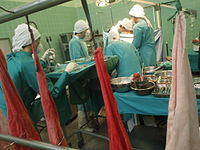
Photo from wikipedia
Staphylococcus infection-associated glomerulonephritis (SAGN) is characterized by the presence of IgA and C3 as the predominant components present in the glomerular immune deposits. Glomerulonephritis frequently resolves after effective treatment of… Click to show full abstract
Staphylococcus infection-associated glomerulonephritis (SAGN) is characterized by the presence of IgA and C3 as the predominant components present in the glomerular immune deposits. Glomerulonephritis frequently resolves after effective treatment of the staphylococcal infection. However, there have been few studies of repeat kidney biopsy after resolution of glomerulonephritis. We present a combined kidney-pancreas transplant patient who developed SAGN due to Staphylococcus aureus bacteremia from an old infected arteriovenous (AV) graft, which occurred after a long period of stable allograft function. Clinical improvement occurred following surgical debridement and appropriate antibiotics with subsequent clearance of bacteremia. However, 3 weeks later he presented with severe acute kidney injury related to rapidly progressive glomerulonephritis. Renal allograft biopsy revealed immune complex glomerulonephritis with predominance of IgA and C3 in subendothelial and mesangial deposits, consistent with SAGN. There was no evidence for recurrent staphylococcal infection. High-dose steroid therapy was followed by resolution of hematuria and improvement in allograft function with gradual return of serum creatinine concentration to near baseline levels. However, 1 year after the diagnosis of SAGN, he developed gradually worsening allograft function with persistent proteinuria. Repeat allograft biopsy showed sclerosing glomerular changes and extensive interstitial fibrosis and tubular atrophy. There was complete resolution of proliferative changes, and IgA and C3 deposits were no longer detectable. Despite transient allograft function stabilization, the patient progressed to end-stage renal disease (ESRD), and maintenance hemodialysis was reinitiated 2.5 years after the diagnosis of SAGN. Pancreatic allograft function remained normal. .
Journal Title: Clinical nephrology
Year Published: 2020
Link to full text (if available)
Share on Social Media: Sign Up to like & get
recommendations!